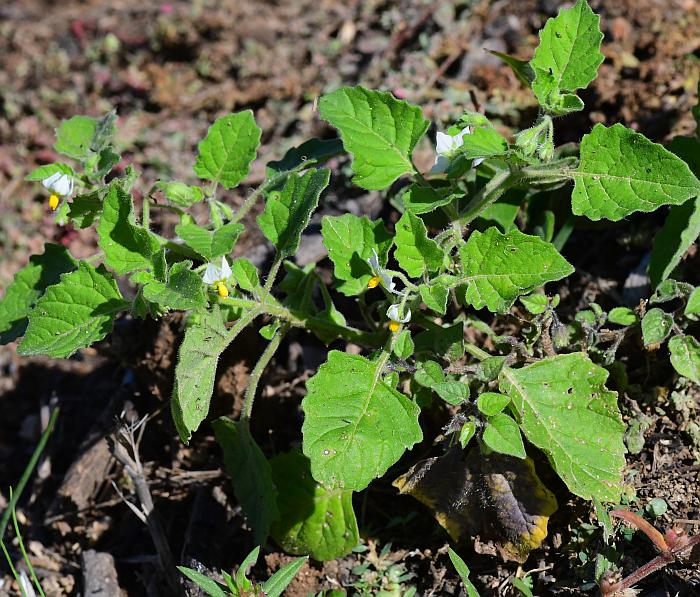Solanum sarrachoides Sendtn.
Hairy Nightshade

Introduced
CC = *
CW = 5
MOC = 30
© SRTurner
Solanum sarrachoides Sendtn.Hairy Nightshade | |
 |
Introduced CC = * CW = 5 MOC = 30 |
© SRTurner |
|
Family - Solanaceae Habit - Taprooted annual or short-lived perennial forb.
Stems - Erect to ascending or trailing, to 60 cm, herbaceous, fragrant with a pungent sweet scent, densely pubescent with short, spreading, multicellular, gland-tipped hairs and scattered, longer, spreading, often nonglandular hairs; unarmed, somewhat sticky.
Leaves - Alternate, simple, petiolate. Petioles to 3.5 cm long, densely glandular-pubescent, often narrowly winged above the midpoint. Blades 1-8 cm long, simple, ovate, oblong-ovate, or triangular-ovate, angled or tapered to a usually sharply pointed tip, angled to rounded or occasionally truncate to slightly cordate at the base, the margins entire or more commonly wavy to bluntly toothed, the surfaces moderately to densely pubescent with short, spreading, multicellular, gland-tipped hairs, somewhat sticky.
Inflorescence - Axillary umbels of 3-5 flowers, the stalks nearly equal, to 6 mm long, glandular-pubescent, thickened toward the tips. Flowers spreading to more or less pendent. Peduncles 5-6 mm long, glandular-pubescent.
Flowers - Calyces 3-6 mm long at flowering, becoming enlarged to 6-11 mm at fruiting, 5-lobed to below the midpoint, the lobes equal, oblong-lanceolate, the outer surface densely glandular-hairy. Corollas 5-8 mm long, white to pale cream-colored, usually yellow to yellowish green in the throat, lobed to at or above the midpoint, the lobes broadly triangular, spreading at full flowering, the inner surface glabrous, the outer surface minutely nonglandular-hairy, especially toward the tip. Stamens 5, the anthers 1.6-2.0 mm long, yellow, oblong, lacking a sterile tip, dehiscing by terminal pores. Ovary green, glabrous, 1.2 mm in diameter, 2-locular, the style not or only slightly exserted from the anther ring, densely pubescent near the stigma.
Fruits - Globose berries 0.6-0.8 cm long, the basal half closely cupped by the persistent calyx tube, usually with 4-6 stony granules, the surface glabrous, olive green to brownish green at full maturity, shiny when young, but dull at maturity, when immature often with scattered, small white flecks or lighter mottling. Seeds 1.3-1.5 mm in longest dimension, broadly obovate to nearly circular in outline, often minutely notched at the attachment point, moderately to strongly flattened, unwinged, the surface faintly and minutely pitted, often appearing nearly smooth, yellow.
Flowering - July - October. Habitat - Streambanks, bottomland forests, glades, pastures, fencerows, farmyards, gardens, railroads, roadsides, open disturbed areas. Origin - Native to South America. Lookalikes - S. ptychanthum, S. americanum. Other info. - Steyermark knew this plant only from the St. Louis railyards. Since that time it has expanded its range in Missouri to include a number of counties, predominantly in the southwestern quadrant of the state. It is generally uncommon in the continental U.S., reported from widely scattered counties in a few eastern-central states. Its appearance is similar to the much more common black nightshade (S. ptychanthum), except that the foliage is glandular-hairy and somewhat sticky or clammy to the touch. The combination of the viscid foliage along with the small white flowers with fused anther columns is diagnostic for this species in Missouri. Photographs taken along a roadside west of Duck Creek Conservation Area, Wayne County, MO, 10-12-2021 (SRTurner). |